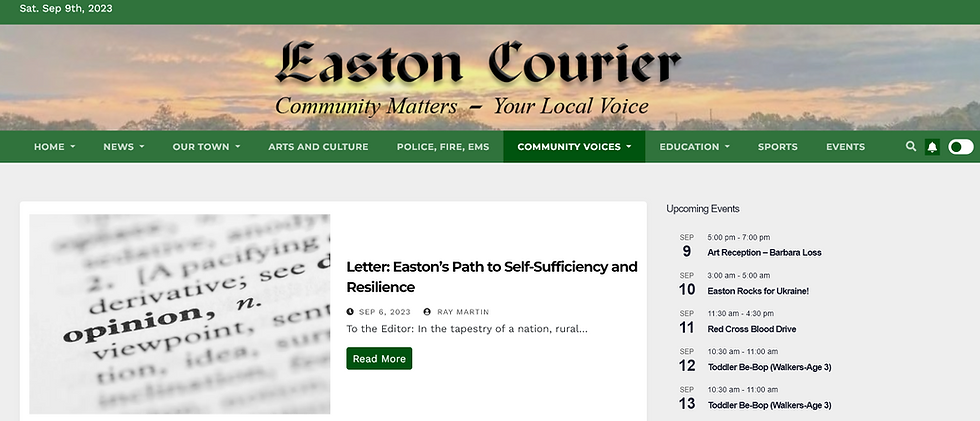Ray Martin Easton, CT Letter to the Easton Courier: Easton’s Path to Self-Sufficiency and Resilience
- Ray Martin Easton CT

- Sep 9, 2023
- 2 min read
www.TheRayMartinAgency.com In the tapestry of a nation, rural communities are the threads that hold the fabric together. Yet, many of these community’s grapple with challenges such as limited resources and dependence on neighboring municipalities for basic needs. The key to Easton’s future lies in fostering self-sufficiency, bolstering resilience, and reclaiming control over our destiny. Furthermore, we need to look past the mis-information being spread by a small group of people in town.
1. Local Resource Utilization: Rural areas often possess untapped resources that can fuel their self-sufficiency. From agricultural land to renewable energy sources, identifying and harnessing these assets can create economic opportunities and reduce reliance on external support.
2. Diverse Economic Ventures: Encouraging a range of local businesses, from farming and agro-processing to crafts and eco-tourism, can diversify the economic base. This not only generates income but also strengthens the community’s ability to fulfill its own needs.
3. Infrastructure Development: Basic infrastructure is the backbone of self-sufficient communities. Access to clean water, efficient transportation, and modern communication networks can bridge gaps, enhance living standards, and enable business growth.
4. Knowledge and Skill Enhancement: Empowering Easton residents with education and skills equips them to contribute effectively to local development. This can lead to innovation, entrepreneurship, and reduced dependence on external expertise.
5. Community Collaboration: Self-sufficiency thrives when communities collaborate. Establishing cooperatives, community gardens, and shared facilities fosters collective ownership and mutual support.
6. Sustainable Practices: Easton should embrace sustainability as a guiding principle. Implementing eco-friendly practices and adopting renewable energy sources not only protects the environment but also creates a resilient foundation for the future.
7. Government Support: Government policies that incentivize local development, offer training programs, and allocate resources to rural areas are pivotal in fostering self-sufficiency.
8. Technology Integration: Leveraging technology, such as e-commerce platforms and online learning, connects rural communities to broader markets and educational opportunities, reducing geographical limitations.
9. Cultural Preservation: Embracing and celebrating local culture can attract tourism, create niche markets for artisanal products, and instill a sense of pride among residents.
10. Long-term Vision: Developing self-sufficient rural communities requires a long-term perspective. Patience, perseverance, and continuous adaptation to changing circumstances are essential.
In the journey towards self-sufficiency, Easton will transform from passive recipient of aid to active architects of its destiny. By harnessing local resources, fostering economic diversity, and prioritizing infrastructure, education, and sustainability, Easton can emerge as a resilient and vibrant hub, shaping our future on our own terms. Easton needs to form a town charter with all these things in mind.
Contact Ray at ray@theraymartinagency.com or 203.900.8975 Ray Martin Easton CT Ray Martin, Ray Martin Stratford, Ray Martin Easton, Ray Martin Connecticut, Ray Martin Real Estate, Martin Caselli





Comments